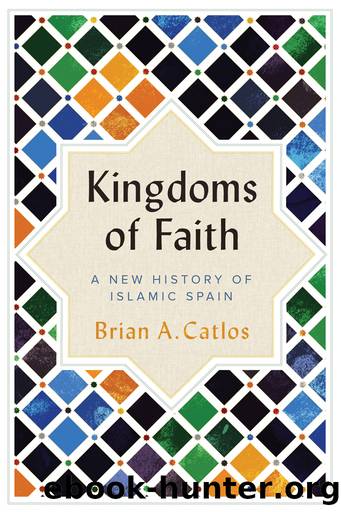Kingdoms of Faith by Catlos Brian A.;

Author:Catlos, Brian A.;
Language: eng
Format: epub
Publisher: C. Hurst and Company (Publishers) Limited
Published: 2018-03-15T00:00:00+00:00
The âPalace of Pleasuresâ (AljaferÃa Palace, Zaragoza); exterior. Turol Jones, 2004 (Creative Commons)
Under his patronage, Zaragoza became an important center of both Arabic and Hebrew letters and home to such literary giants as the poets and grammarians Muhammad ibn Bajja (âAvempace,â to the Latin world) and the Jew Solomon ibn Gabirol (who worked mostly in Arabic). Like so many of their fellow Zaragozan men of letters, these two were also physicians and intellectual polymaths: Ibn Bajja, a philosopher, composer, and astronomer, and Ibn Gabirol, a philosopher and grammarian. In fact, the city was most famous as a center of mathematics, astronomy, medicine, and philosophy. It was home to a score of leading twelfth-century Muslim and Jewish scholars who had been swept up by both the rationalistic Aristotelian revolution and the revival of Neoplatonism that were transforming the theological and intellectual landscape of the Islamic world and that would soon provide the foundations for the European Renaissance and the new esoteric movements that developed in all three of the Abrahamic religions.
Al-Muqtadirâs son and successor, Yusuf al-Muâtaman, who came to power in 1081/2, was himself one of the most notable mathematicians of his age and emulated his fatherâs support of the sciences. Zaragoza continued to produce top-ranked scholars even as it began to unravel politically in the late eleventh century. Jewish intellectual life was particularly robust in the city. Abu âl-Hasan Judah ha-Levi, the author of the anti-Aristotelian Jewish apologetic the Kitab al-Khazari (âThe Book of the Khazar,â also known as âThe Book of Proof and Defense of the Despised Religionâ), lived here. So did his close friend, the poet, exegete, and grammarian Abraham ben Ezra (or Abu Ishaq), regarded second only to his contemporary, the great French rabbi Rashi, for his Biblical commentaries. Abu Fadl ibn Hasday, a poet, musician, astronomer, and mathematician, and a grandson of the great Hasdai ibn Shaprut, was a favorite of al-Muqtadir and al-Muâtaman. He served them as katib and wazir and eventually converted to Islam, supposedly out of love, but more likely to advance his career. But if Abu Fadl chose Islam, others would convert to Christianity as the balance of power in the region shifted toward the north. The most notable was Moses Sephardi, baptized in 1106 as Petrus Alfonsi, who wrote both a compilation of Near Eastern fables called the Disciplina Clericalis and a seminal anti-Jewish tract, The Dialogue Against the Jews. In 1116, he became physician to Henry I, king of England.
But for all the cross-cultural collaborations that characterized the court of the Banu Hud, one of the most curious and portentous exchanges took place between an anonymous Christian cleric and the philosopher Abuâl-Walid Sulayman ibn Baji sometime in the early 1070s. Details are sketchy, but it seems that two Christian monks arrived in Zaragoza from Frankish lands and delivered a courteous, formal letter âto the beloved friend . . . the noble king,â al-Muqtadir, politely excoriating Islam as an invention of the Devil and inviting him to convert to Christianity.32 The
Download
This site does not store any files on its server. We only index and link to content provided by other sites. Please contact the content providers to delete copyright contents if any and email us, we'll remove relevant links or contents immediately.
| Africa | Americas |
| Arctic & Antarctica | Asia |
| Australia & Oceania | Europe |
| Middle East | Russia |
| United States | World |
| Ancient Civilizations | Military |
| Historical Study & Educational Resources |
The Battle of Mogadishu by Matt Eversmann & Dan Schilling(723)
The Confidence Men by Margalit Fox(672)
The Spymaster of Baghdad by Margaret Coker(643)
A History of the Muslim World since 1260: The Making of a Global Community by Vernon O. Egger(642)
Jack the Ripper and the East End by Peter Ackroyd(611)
Empire of Fear: Inside the Islamic State by Andrew Hosken(589)
The Afghanistan File by Prince Turki AlFaisal Al Saud(586)
The Crimean War by Winfried Baumgart(579)
Islam At The Gates: How Christendom Defeated the Ottoman Turks by Diane Moczar(574)
The Jerusalem Diamond by Noah Gordon(568)
Akhenaten by Dominic Montserrat(566)
A Concise History of Greece (Cambridge Concise Histories) by Richard Clogg(556)
Beirut 2020 by Charif Majdalani(555)
The History of Jihad by Robert Spencer(550)
Enemy in the East by Rolf-Dieter Müller(536)
Israel: Ancient Kingdom or Late Invention? by Daniel I. Block(532)
The Privatization of Israeli Security by Shir Hever(527)
The Nine Lives of Pakistan by Declan WALSH(522)
Destroying a Nation: The Civil War in Syria by Nikolaos van Dam(516)
